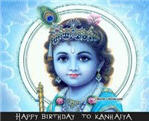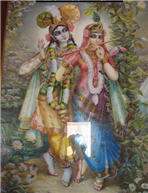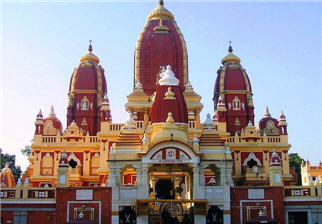Happy Birthday Krishna: 22nd August
Deborah Swallow | August 22nd, 2011 in : days of significance, General, other interesting stuff, social practices, South Asia
On 22nd August 2011, Hindus around the world will be celebrating
Krishna Janmashmati, the birth of their deity Lord Sri Krishna. Krishna is seen as the source of joy and his birthday is one of the most important celebrations in the Hindu calendar. Sri Krishna lived in luxury throughout his life and so the festival is celebrated with great splendour. As well as celebrating the birth of Sri Krishna, the festival symbolises the lighting of the spark of the Divine power in every human being.
Sri Krishna was born in the ‘Rohini’ nakshatram (star) to King Vasudeva and Devaki Devi on the eighth day of the dark fortnight in the month of Sravana. The festival can fall any time in August and September.
Who was Sri Krishna?
Sri Krishna is considered to be the eighth incarnation of Lord Vishnu, one of three major Hindu gods on earth. It is said that Sri Krishna was a manifestation of joy at all levels and in all walks of life. There are many romantic tales written about him and it is said he radiates divine attributes. Many Hindu sages pay homage to his greatness.
Sri Krishna was born in the dungeons of Kansa who was out to kill him at the very moment of his birth. He is said to constantly triumph over mortal dangers and had great intellectual brilliance.
What does the festival symbolise?
 As well as celebrating the birth of Sri Krishna, the festival symbolises the lighting of the spark of the Divine power in every human being, which spurs us on to live in this world with a higher spiritual purpose. Krishna is seen as the source of joy.
As well as celebrating the birth of Sri Krishna, the festival symbolises the lighting of the spark of the Divine power in every human being, which spurs us on to live in this world with a higher spiritual purpose. Krishna is seen as the source of joy.
How is the festival observed?
In many parts of India, the festival will be a two day celebration. The peak of merrymaking will be at midnight of the first day when Krishna was born. An idol of the infant Krishna will be bathed and cradled at midnight. A conch shell will be blown and there will be much merriment and dancing.
Sri Krishna lived in luxury throughout his life and so the festival is celebrated with great splendour. Sweets are made on this day including addus (yellu oonde), chakli, cheedai, payasam (kheer), and so on. In addition, plenty of milk products especially butter, which was Sri Krishna’s favourite childhood food, is given in offerings. A wide variety of fruits are also offered. The most common sweets made are laddus and payasam.
Sweets will be offered to idols of Krishna in a ritual known as ‘bhog’.
As well as delicious food, Hindus take part in a raas or dance, taking part in great spiritual fervour as Krishna is the source of great spiritual joy, the highest level of joy. People enjoy in the merrymaking at the midnight of ashtami, by singing devotional songs and dancing to the tune of bhajans.
Dance drama, known as Raslila, is performed. Incidents from Sri Krishna’s life, especially his childhood, are depicted in the drama. On the second day of the festival, a popular ceremony known as ‘Dahi Handi’ takes place wherein the pot containing curd or butter or milk is broken by the youth.
The ritual of Dahi Handi is carried out with religious observance, in the northern parts of India. A human pyramid tries to break the Handi (earthen pot filled with buttermilk) that is suspended from the top, with the help of a rope.
Hindus strive to reach the highest level and then the festival will take on the full meaning of Sri Krishnaaarpanamastu- ‘Let everything be offered to Krishna’.
I’ve heard some Hindus fast on this day, is this true?
Yes. Some devotees will fast in the honour of Lord Krishna, known as ‘Nirjal Vrat’. There are other devotees who observe two day fast in the honour of Lord Krishna.
Why do Hindus chant on Krishna Janmashmati?
It has been said that chanting Lord Krishna’s name with love and devotion brings immense joy and pleasure to the life of the devotee. There will be continuous chanting of his name for the entire day. It is said that chanting 108 names of Lord Krishna brings auspiciousness in one’s life.
How do Hindus celebrate around the world?
Most Hindus will go to their temple to offer prayers to Krishna and cultural programmes in their community will also be organised.
LAXMI NARAYAN TEMPLE in Delhi
 I had the priviledge of travelling to Delhi for the first time earlier this year. One of the highlights for me was a visit to the Laxmi Narayan Temple which was breathtakingly beautiful and is a MUST SEE for any visitor to the city. The temple attracts thousands of devotees on Janmashtami day, the birthday of Lord Krishna.
I had the priviledge of travelling to Delhi for the first time earlier this year. One of the highlights for me was a visit to the Laxmi Narayan Temple which was breathtakingly beautiful and is a MUST SEE for any visitor to the city. The temple attracts thousands of devotees on Janmashtami day, the birthday of Lord Krishna.
Lakshmi Narayan Mandir is located west of Connaught Place in New Delhi. Created by Raja Baldev Das in 1938, is dedicated to Vishnu and goddess Lakshmi. It has a dedicated shrine to Krishna.
Also known as Birla Mandir in New Delhi, this temple has a very interesting history attached to it. Built over a period of six years, the temple was inaugurated by Mahatma Gandhi. But he kept a condition that will inaugurate the Delhi Laxmi Narain Temple, where people of all castes especially untouchables, would be able to enter.

Tags: about, bhog, celebrations, Dahi Handi, festival, food, hindu, Krishna Janmashmati, LAXMI NARAYAN TEMPLE

 Hello, I'm Deborah Swallow and, for the last fifteen years, I've worked in over thirty countries addressing the complexities of people working internationally across multiple cultures, so individuals and organisations alike can gain an authentic competitive edge and win in international markets.
Hello, I'm Deborah Swallow and, for the last fifteen years, I've worked in over thirty countries addressing the complexities of people working internationally across multiple cultures, so individuals and organisations alike can gain an authentic competitive edge and win in international markets. 